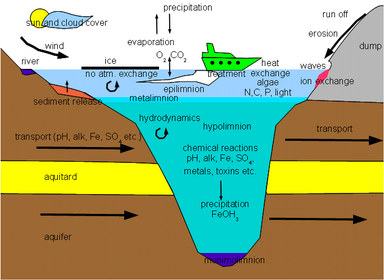Mike Mueller (1), Katja Eulitz (1), Clint McCullough (2) Mark Lund (2)

Understanding Coal Pit Lake Resources within the Collie Basin Project
Funding: Department of Water (Western Australia) and Australian Government’s “Water for the Future” initiative
How does pit lake water quality and depth change under different management scenarios?
Stage 1. Selection of appropriate model
This model will maximise the use of the currently available data for model creation and validation. The current preference is not to focus on a single pit lake and model in detail but develop a simpler model that can be easily applied to cohorts of Collie pit lakes identified by the inventory collection and conceptual modelling. This general model would be less detailed but more suited to the low input knowledge environment of the Collie groundwater region and would support important pit lake and groundwater management decisions.
Stage 2: Model parameterisation and testing.
There is no option for detailed validation of the model at this stage, other than through the use of existing historic and collection of new data sets arising from Task 1.
Stage 3: Scenario testing.
A series of different scenarios will be run to demonstrate model outputs and to test alternative pit lake management and environmental strategies for the different pit lake cohorts.
Modelling Tools
This project is using the model PITLAKQ which is a coupled model that combines the groundwater model PCGEOFIM, the lake hydrodynamic and water quality model CE-QUAL-W2 and the hydro-geo-chemical model PHREEQC.
PITLAKQ is capable of modelling all processes that are important to pit lake water quality. Fig. 2 shows these processes that include weather induced hydrodynamics with thermal layering, heath and gas exchange with the atmosphere as well as flow, transport and chemical changes in the subsurface. In addition, a wide variety of water quality processes in the lake water such as biological processes including algae growth and nutrient dynamics as well as equilibrium and kinetic chemical reactions can be modelled. Pit lake specific chemical reactions may be defined by means of an extendable hydro-geo-chemical database and rate limited reaction paths.

Important processes in pit lakes
The final models

Lake Kepwari
Recommendations
- Pit lake modelling for Collie is clearly limited by available data both from the pit lakes and particularly from groundwater model results. The groundwater inflow as calculated by the groundwater models deviated considerably from inflows adjusted in this study. This is due to the fact that the groundwater models are large scale models. The lakes are small features and not the main concern of the groundwater modelling studies.
- Bathymetry data are very important to calculate an accurate volume of the lakes and to get a reliable representation of the spatial distribution of shallow and deep areas of a lake.
- The relative contributions to the pit lake acidity budgets from surface and groundwaters across the different pit lake types are still not well understood.
- Remediation of lakes by alkaline material addition has been both attempted and reported in previous studies. The effects of lake treatment with different alkaline substances can be represented in the model. Required model inputs for this task are amount and schedule of addition as well as the chemical composition of the added substance. The substance efficiency in the chemical reactions is less than 100% per cent. There can be many reasons for this such as the partial solution of solids, reaction with other species and resulting precipitation or sedimentation before the chemical reaction is complete.
Outputs
Müller, M.; Eulitz, K.; McCullough, C. D. & Lund, M. A. (2010). Mine Voids Management Strategy (V): Water Quality Modelling of Collie Basin Pit Lakes. Department of Water Project Report MiWER/Centre for Ecosystem Management Report 2010-10, Edith Cowan University, Perth, Australia. 95pp. Unpublished report to Department of Water. link
McCullough, C. D.; Müller, M.; Eulitz, K. & Lund, M. A. (2011). Modelling a pit lake district to plan for abstraction regime changes. Mine Closure 2011: Proceedings of the Sixth International Conference on Mine Closure. Lake Louise, Canada. Fourie, A. B.; Tibbett, M. & Beersing, A. (eds.), Australian Centre for Geomechanics (ACG), Perth, Australia, 581-592pp. PDF
Müller, M.; Eulitz, K.; McCullough, C. D. & Lund, M. A. (2011). Model-based investigations of acidity sinks and sources of a pit lake in Western Australia. Proceedings of the International Mine Water Association (IMWA) Congress. Aachen, Germany. 41-45pp. PDF
